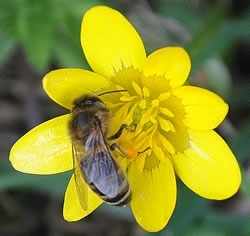Honeybee
 There is just one species of honeybee (Apis mellifera) found throughout Europe, America and Australasia, although there are different species to be found in Asia.
There is just one species of honeybee (Apis mellifera) found throughout Europe, America and Australasia, although there are different species to be found in Asia.
For thousands of years, people have gathered honey from wild bee colonies that could be found in old trees and rock crevices. Then, around the middle of the 19th Century, we began to build wooden houses, or beehives as they became known, which had internal frames that could be removed, so as to collect the honey.
A honeybee colony is an amazing place. In the summer months, a colony can contain 60,000 bees, dropping to around 10,000 bees during the winter months. The fact that a honeybee colony continues to stay “alive” over winter surprises many. The bees gather together around the food supply in clusters and become relatively inactive, only moving now and then to feed or to move from the outside of the cluster to the inside, to gain more warmth from their comrades.
For much of the year a colony will support just one queen bee, who will lay her eggs in the hexagonal cells made from beeswax, from January right through until late autumn, which hatch out into female worker bees. During the spring and summer months she will also lay eggs that will produce males, or drones. The main job of these drones is to mate with queen bees during “swarming”.
The first swarm of the season invariably contains the “old” queen, who will leave her colony to set up a new colony elsewhere, leaving some virgin queens behind in the old nest. If conditions are favourable, some of these new queens may survive and leave the nest to swarm with drones and form their own new colonies too.
Female worker bees fulfil all sorts of different jobs. She may start off her days with housework – cleaning and feeding the brood and attending the queen. Then she will progress to being in charge of the nectar and honey that is in the hive, and making the hexagonal wax combs. Then she will move onto hive ventilation (an important job – to keep the colony at a constant temperature) and also guard duties, stopping unwanted guests from entering the colony.
Eventually she will be promoted to collecting pollen and nectar from the surrounding countryside and also a resinous plant substance called propolis, which is used as an antiseptic within the hive. After all this hard work she will eventually die.
Typically a colony needs about 120kg of nectar per year to fuel growth and development during the active period, and at least 16kg of honey to make sure that the colony can survive the winter months. The nectar collected by the bees is carried back in their “honey stomach” – remember this when you next eat honey!
The pollen collected from flowers is also hugely important in supplying a range of requirements that a thriving colony needs – perhaps the most essential being protein. A colony will need somewhere in the order of 30kg to be collected if it is to flourish and this is carried back to the hive in “baskets” situated on their hind legs.
Each bee’s basket load typically contains around 10-30mg, which means that to collect the 30kg that the colony requires, around 1.5 million journeys will have to made!
Finding a good source of flowers within the countryside is made easier by returning honeybees performing a dance, informing other female workers exactly where the flowers that they have found are located.
Various dances, which include waggling, vibrating, buzzing and shaking, help other workers to head off in the correct direction to quickly locate the blooms, thereby wasting as little energy as possible.
So, the next time you tuck into some delicious honey, take a moment to think back to all the hard teamwork and skill that has gone into making your nutritious treat!
Peter Thompson
Advisory
Read more from Peter Thompson at his blog.

Download Peter Thompson's essential 26-page book, featuring beautiful photography and detailed profiles of Britain's wildlife
Download FREE >